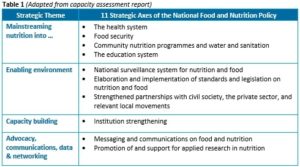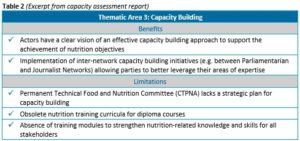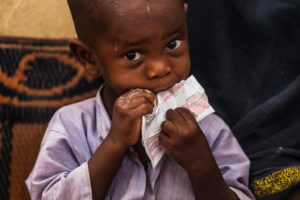Nutrition Capacity Assessment anchors multi-sectoral actions to ameliorate Chad’s dire nutrition situation
* Originally published by the UN Network for SUN The nutrition statistics for Chad are daunting. According to the 2018 State of Food Security and Nutrition in the World (SOFI) report, child stunting in Chad (39.9 per cent) is climbing, well exceeding the new ‘very high’…
* Originally published by the UN Network for SUN
The nutrition statistics for Chad are daunting. According to the 2018 State of Food Security and Nutrition in the World (SOFI) report, child stunting in Chad (39.9 per cent) is climbing, well exceeding the new ‘very high’ population threshold (30 per cent) being used by WHO and UNICEF. In some pockets of country, the prevalence of stunting exceeds 50 per cent. The exclusive breastfeeding rate, one of the most effective nutrition actions, has fallen to a dismal 0.1 per cent. While overweight and obesity levels are low, a slight increase was reported in the prevalence of adult obesity further complicating the situation. How is this possible given the attention the Government of Chad has devoted to nutrition in recent years and the myriad of external assistance it has received?
The country’s high exposure to climate extremes as well as conflict are contributing to the high levels of malnutrition (SOFI 2018). These shocks undermine ongoing efforts to improve food security, care practices, access to health services and safe water as well as the sanitation environment. A nutrition capacity assessment, supported by the UN [Nutrition] Network’s (UNN) intensive service REACH, sheds additional light. In many ways, the capacity assessment exercise reflects the crescendo of efforts to address the country’s malnutrition situation to improve nutrition governance and animate a multi-sectoral approach that addresses the causes of malnutrition at all levels.
The assessment unfolded over a three-month period, enabling the consultants to speak with several participants. The REACH Facilitator played an integral role, advocating for the study, which was covered by REACH funding. The idea was initially pitched to the UN Network focal points and the SUN Focal Point, who were actively engaged throughout the process and to ensure engagement across sectors. In addition, the UNN Secretariat supported the Facilitator by imparting learning from similar assessments in other countries (e.g. Burkina Faso, Lesotho and Senegal).
Taking the form of a qualitative study, information was gathered through a desk review, key informant interviews and focus groups with representatives from government and the respective SUN networks, including the UN Network. The assessment team measured capacities in four strategic areas: 1) the integration of nutrition into four main sectors; 2) enabling environment; 3) capacity building; and 4) advocacy, communications, data and networking. It also took into account the eleven pillars of the National Food and Nutrition Policy, 2014 – 2025 (Politique Nationale de Nutrition et d’Alimentation or PNNA), understanding that they constitute the functions of the CTPNA, and thus should be part and parcel of the assessment.
 The study focused on the functional capacities of the Permanent Technical Food and Nutrition Committee (Comité Technique Permanent de Nutrition et d’Alimentation or CTPNA), led by the SUN Focal Point and supported by eight SUN networks*. In addition, it also encompassed newly established food and nutrition committees in five regions – Guéra; Logone Occidental; Ouaddaï; Tandjilé; and Wadi Fari – looking at their respective capacity to plan, manage and coordinate nutrition actions. Not only did the assessment identify a series of capacity development needs, it also documented strengths and achievements.
The study focused on the functional capacities of the Permanent Technical Food and Nutrition Committee (Comité Technique Permanent de Nutrition et d’Alimentation or CTPNA), led by the SUN Focal Point and supported by eight SUN networks*. In addition, it also encompassed newly established food and nutrition committees in five regions – Guéra; Logone Occidental; Ouaddaï; Tandjilé; and Wadi Fari – looking at their respective capacity to plan, manage and coordinate nutrition actions. Not only did the assessment identify a series of capacity development needs, it also documented strengths and achievements.
This enabled country actors to build upon these strengths when tackling the current challenges. In this light, the report positioned the members of the CTPNA both as change agents and recipients of capacity development activities, outlined in the 5-year nutrition capacity development plan.
 Among the key findings, the assessment revealed that sectoral participation in monthly CTPNA meetings is variable as is the functionality of the regional coordination committees and the extent to which nutrition is institutionalised within related sectors. It recommended efforts to mainstream nutrition within the line ministries, including in sectoral policies. It also found that many communication activities regarding the multi-sectorality have been carried out by various actors, such as the CTPNA steering committee and the SUN networks (Parliamentarian, Civil Society and UN). With that said, it recommended improving CTPNA’s internal and external communications in order to leverage its members’ ability to further institutionalize nutrition within the health, education, agriculture and WASH sectors.
Among the key findings, the assessment revealed that sectoral participation in monthly CTPNA meetings is variable as is the functionality of the regional coordination committees and the extent to which nutrition is institutionalised within related sectors. It recommended efforts to mainstream nutrition within the line ministries, including in sectoral policies. It also found that many communication activities regarding the multi-sectorality have been carried out by various actors, such as the CTPNA steering committee and the SUN networks (Parliamentarian, Civil Society and UN). With that said, it recommended improving CTPNA’s internal and external communications in order to leverage its members’ ability to further institutionalize nutrition within the health, education, agriculture and WASH sectors.
In general, the study found that the country has taken great strides to create a solid foundation in terms of nutrition governance frameworks, coordination architecture and political commitment to combat malnutrition in the country. Further efforts – including capacity development activities to formalize the modus operandi of CTPNA as well as the articulation of a strategic vision for the CRNAS – are needed to translate this into concrete action. With these insights, the nutrition coordination platforms will be better equipped to operationalize the PNNA and the supporting Inter-Sectoral Nutrition and Food Plan (PAINA) at all levels. Country actors found the exercise to be useful in that it provided a context-specific diagnostic and avenues for action-based solutions. A Nutrition Stakeholder and Action Mapping was launched on 10 December 2018, thanks to UNN-REACH support and generous EU funding, to ascertain the coverage levels of core nutrition actions. The mapping will further build Government capacity to better coordinate nutrition action across diverse stakeholder and sectors in pursuit of common nutrition goals.
*Note: These SUN networks include: 1) the UN Network; 2) the Civil Society Network; 3) the Donor Network; 4) the Business Network; 5) the Parliamentarian Network; 6) the Scientific Network; 7) the Journalists Network; and 8) the Champion’s Network.
